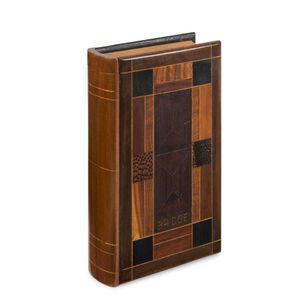Griffiths' Royal Playing Card Casket
You must be a subscriber, and be logged in to view price and dealer details.
Subscribe Now to view actual auction price for this item
When you subscribe, you have the option of setting the currency in which to display prices to $Au, $US, $NZ or Stg.
- Casuarina - Casuarina, is also known as beefwood (because of its appearance) she-oak, swamp oak, river oak, forest oak and Botany Bay wood. It is a native Australian hardwood, red brown in colour with dark flecks.
- Maple - Maple, native to North America, is a dense heavy timber from light to yellow-brown in colour. It has very little distincive graining unless it is one of the variants such as birds-eye maple or burr maple, so was not used extensively for furniture in 18th and 19th century, where cabinetmakers and designers preferred timbers with more distinctive features such as mahogany, walnut, rosewood and oak.
Birds-eye maple has a seres of small spots linked by undulating lines in the grain, is highly sough and is used as a decorative veneer. Burr maple has larger and irregular grain swirls than birds-eye maple. - Circa - A Latin term meaning 'about', often used in the antique trade to give an approximate date for the piece, usually considered to be five years on either side of the circa year. Thus, circa 1900 means the piece was made about 1900, probably between 1895 and 1905. The expression is sometimes abbreviated to c.1900.
- Ebony - Ebony is a close grained timber, black in colour. It has a fine texture which can be polished to a high gloss, making it suitable for venereering, inlay and stringing and its use as solid timber is resticted to small decorative items and ornamental decoration, such as chess pieces and musical instrument parts. The term "ebonised" means "faux ebony", timber that has been darkened during the polishing process to resemble ebony.
This item has been included into following indexes:
Visually similar items

Cricket Bat Display Cases, each 25 x 96 cm. (4 items)

A pair of oak roll front filing cabinets, circa 1900, 116 cm high, 44 cm wide, 40 cm deep

A hardwood display cabinet, of stepped rectangular form on short corner feet, the taller central section with a glazed door opening to reveal four shelves, flanked by two shorter hardwood doors, the exterior carved overall with blossoming prunus boughs, 16

A Victorian oak bedside cabinet, in quarter-cut oak crossbanded to the top, panelled to the door with flamed veneered timber framed by a reed of Tunbridge ribbon inlay and with further figured timber inlays to the canted corners and plinth base. 40 cm x 35
